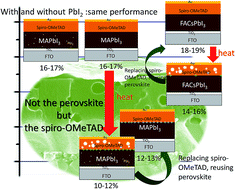当前位置:
X-MOL 学术
›
J. Mater. Chem. A
›
论文详情
Our official English website, www.x-mol.net, welcomes your
feedback! (Note: you will need to create a separate account there.)
Role of spiro-OMeTAD in performance deterioration of perovskite solar cells at high temperature and reuse of the perovskite films to avoid Pb-waste†
Journal of Materials Chemistry A ( IF 10.7 ) Pub Date : 2018-01-02 00:00:00 , DOI: 10.1039/c7ta07674f Ajay Kumar Jena 1, 2, 3 , Youhei Numata 1, 2, 3 , Masashi Ikegami 1, 2, 3 , Tsutomu Miyasaka 1, 2, 3
Journal of Materials Chemistry A ( IF 10.7 ) Pub Date : 2018-01-02 00:00:00 , DOI: 10.1039/c7ta07674f Ajay Kumar Jena 1, 2, 3 , Youhei Numata 1, 2, 3 , Masashi Ikegami 1, 2, 3 , Tsutomu Miyasaka 1, 2, 3
Affiliation

|
As the long-term stability and toxicity of Pb are two profound concerns for the commercialization of Pb-based perovskite solar cells, we have undertaken this study to understand the performance degradation of perovskite solar cells at high temperature (60, 80, 100 and 120 °C) and under a humid (30–50% relative humidity) environment, and then tried to reuse the perovskite films from the degraded cells to recover the cell efficiency so as to avoid dumping of Pb-waste into the environment. As found in this study, the performance of MAPbI3 (MA = CH3NH3) cells using spiro-OMeTAD as the hole transport material (HTM) deteriorated mainly not due to the degradation of the perovskite but because of the modification of the interface between the perovskite and spiro-OMeTAD at high temperature. In addition, the spiro-OMeTAD layer underwent a severe morphological deformation at high temperature, showing large voids in it, which reduced the cell performance further. However, despite the complete reconversion of PbI2 to perovskite and the replacement of the degraded spiro-OMeTAD film with a fresh layer in the MAPbI3 cells, the cell performance was not recovered to the initial value because the modified perovskite/spiro-OMeTAD interface became worse after recycling. The thermal stability and performance recovery upon recycling were found to depend on the composition of the perovskite; faster degradation of MAPbI3 cells with a slight excess of MAI and better stability of cells not containing MA (FA0.85Cs0.15PbI3, FA = CH(NH2)2) indicated certain involvement of MA+ ions in the alteration of the perovskite/spiro-OMeTAD interface. Unlike the heat-treatment case, MAPbI3 cells, when exposed to a humid environment, degraded significantly to PbI2 and the reconversion of this PbI2 to perovskite followed by deposition of a fresh spiro-OMeTAD layer increased the cell performance but it did not recover to the initial value. This poor recovery in these cells was due to inefficient carrier transport that resulted in a lower photocurrent in the recycled devices.
中文翻译:

spiro-OMeTAD在高温下钙钛矿太阳能电池的性能下降中的作用以及钙钛矿薄膜的再利用以避免Pb废料的作用†
由于Pb的长期稳定性和毒性是基于Pb的钙钛矿太阳能电池商业化的两个重要问题,因此我们进行了这项研究,以了解钙钛矿太阳能电池在高温下(60、80、100和120的性能下降)。 °C)和潮湿(相对湿度30–50%)的环境中,然后尝试从降解的细胞中重新使用钙钛矿薄膜,以恢复电池效率,从而避免将Pb废物倾倒到环境中。如本研究所述,MAPbI 3(MA = CH 3 NH 3)使用spiro-OMeTAD作为空穴传输材料(HTM)的电池的劣化主要不是由于钙钛矿的降解,而是由于高温下钙钛矿与spiro-OMeTAD之间的界面发生了改变。另外,螺旋-OMeTAD层在高温下发生严重的形变,在其中显示出大的空隙,这进一步降低了电池性能。然而,尽管PbI 2完全重新转变为钙钛矿,并且降解的spiro-OMeTAD膜被MAPbI 3中的新鲜层所取代电池,电池性能未恢复到初始值,因为改性的钙钛矿/螺-OMeTAD界面在回收后变得更糟。发现回收时的热稳定性和性能恢复取决于钙钛矿的组成。MAPbI 3细胞降解更快,MAI略有过量,并且不含MA的细胞具有更好的稳定性(FA 0.85 Cs 0.15 PbI 3,FA = CH(NH 2)2)表明MA +离子参与钙钛矿的改变/ spiro-OMeTAD接口。与热处理不同,MAPbI 3细胞在潮湿环境中会显着降解为PbI如图2所示,该PbI 2转化为钙钛矿,随后沉积新鲜的螺-OMeTAD层提高了电池性能,但未恢复到初始值。这些电池回收率差是由于载流子传输效率低下,导致回收装置中的光电流降低。
更新日期:2018-01-02
中文翻译:

spiro-OMeTAD在高温下钙钛矿太阳能电池的性能下降中的作用以及钙钛矿薄膜的再利用以避免Pb废料的作用†
由于Pb的长期稳定性和毒性是基于Pb的钙钛矿太阳能电池商业化的两个重要问题,因此我们进行了这项研究,以了解钙钛矿太阳能电池在高温下(60、80、100和120的性能下降)。 °C)和潮湿(相对湿度30–50%)的环境中,然后尝试从降解的细胞中重新使用钙钛矿薄膜,以恢复电池效率,从而避免将Pb废物倾倒到环境中。如本研究所述,MAPbI 3(MA = CH 3 NH 3)使用spiro-OMeTAD作为空穴传输材料(HTM)的电池的劣化主要不是由于钙钛矿的降解,而是由于高温下钙钛矿与spiro-OMeTAD之间的界面发生了改变。另外,螺旋-OMeTAD层在高温下发生严重的形变,在其中显示出大的空隙,这进一步降低了电池性能。然而,尽管PbI 2完全重新转变为钙钛矿,并且降解的spiro-OMeTAD膜被MAPbI 3中的新鲜层所取代电池,电池性能未恢复到初始值,因为改性的钙钛矿/螺-OMeTAD界面在回收后变得更糟。发现回收时的热稳定性和性能恢复取决于钙钛矿的组成。MAPbI 3细胞降解更快,MAI略有过量,并且不含MA的细胞具有更好的稳定性(FA 0.85 Cs 0.15 PbI 3,FA = CH(NH 2)2)表明MA +离子参与钙钛矿的改变/ spiro-OMeTAD接口。与热处理不同,MAPbI 3细胞在潮湿环境中会显着降解为PbI如图2所示,该PbI 2转化为钙钛矿,随后沉积新鲜的螺-OMeTAD层提高了电池性能,但未恢复到初始值。这些电池回收率差是由于载流子传输效率低下,导致回收装置中的光电流降低。











































 京公网安备 11010802027423号
京公网安备 11010802027423号